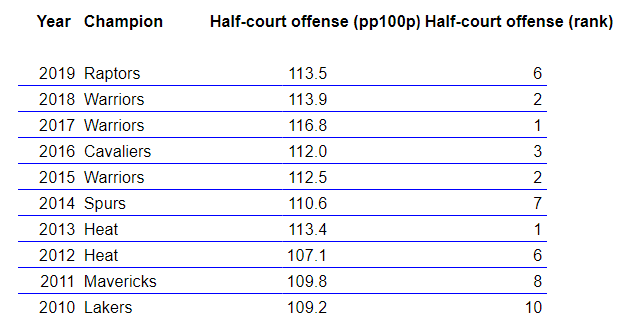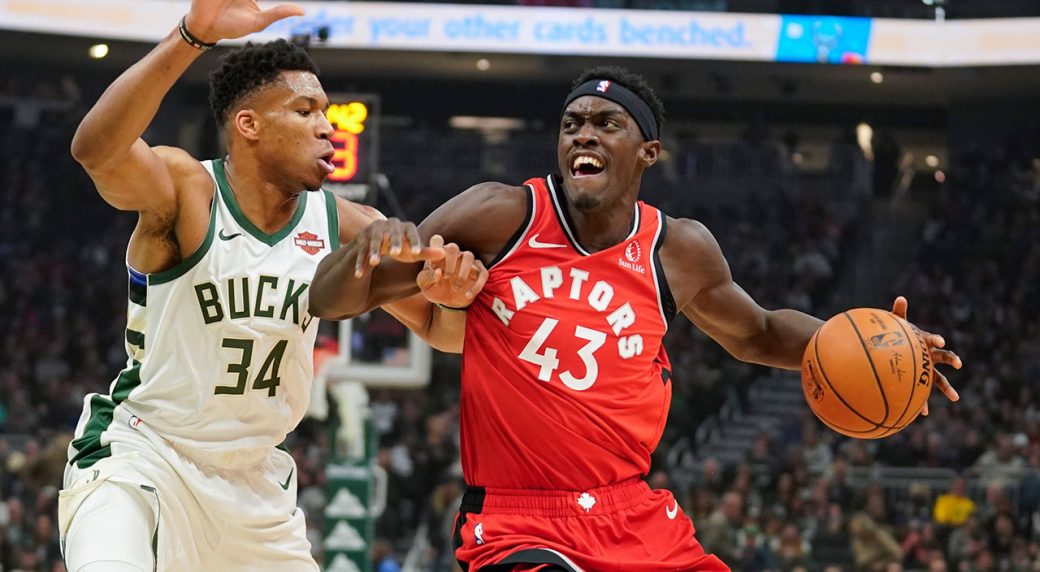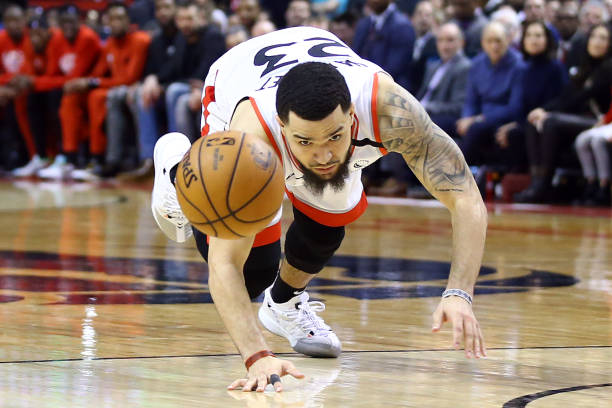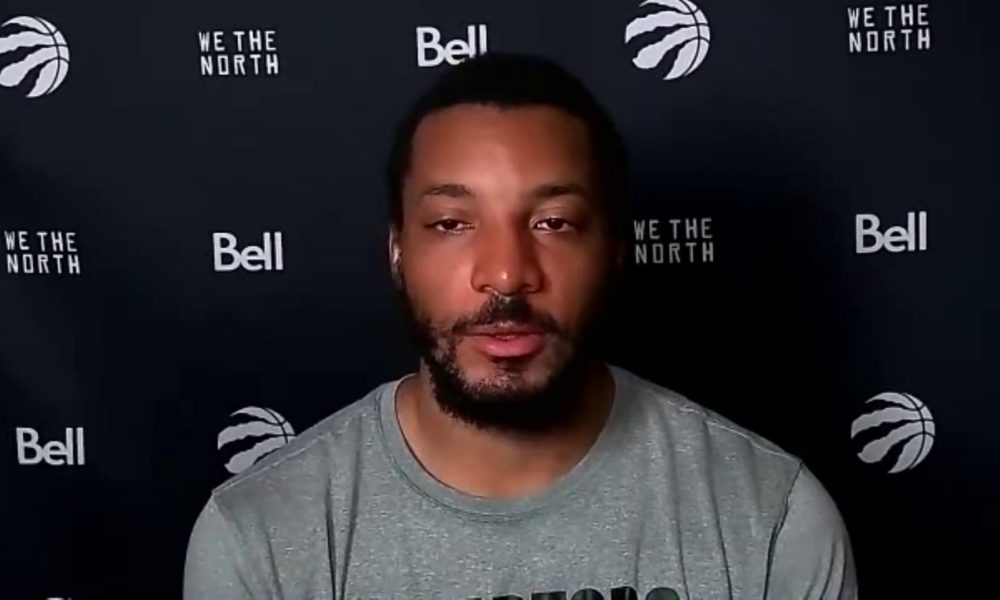When it comes to basketball, there are three realistic ways to interpret information. First, and easiest, you can believe it. Second, and sometimes most fun, is that you can deny it outright. Finally, you can decide it’s valuable to understand, but it shouldn’t have final say on the matter. When it comes to the Toronto Raptors, the numbers say that the team has a half-court offense problem.
Should we believe that?
Let’s start by establishing what it means to say that the Raptors have a half-court offense problem. It’s not that Toronto’s half-court offense is bad. It just didn’t seem good enough to, say, win a championship. According to Cleaning the Glass, the Raptors had the 14th-best half-court offense in the league this year. 18th-best if you fiddle with the numbers to account for points per 100 plays rather than points per 100 possessions (pp100p), thus accounting for Toronto’s intentionally anemic offensive rebounding.

No champion in the past ten years has had a half-court offense so middling as Toronto’s.
In fact, trawling through all of the past champions in the history of Cleaning the Glass’s archives, only Ben Wallace’s defense-focused Detroit Pistons, with a half-court offense ranked 13th-best in the league, sported a comparable offense to Toronto’s this year. To be fair, Toronto’s current pp100p of 111.6 is excellent compared to champions of a bygone era, but potential playoff foes like the Milwaukee Bucks, Boston Celtics, Los Angeles Clippers, and even Miami Heat were better this year than Toronto in the half-court. Against the best ten teams in the league, Toronto struggled to the fourth-worst half-court offense in the league. So that’s what the numbers say. Let’s try to make sense of it.
First and foremost, the Raptors were bitten by the injury bug this year. Bad. Six of their top seven players missed double digit games to injury, and the Raptors suffered the third-most in the league in terms of value lost to injury (behind only Kevin Durant’s Brooklyn Nets and, somehow, the Celtics.) That matters, and because multiple Raptors missed games in separate chunks rather than all at once, the team fielded a different roster seemingly every game. It was difficult to find consistency, which hurts an offense. To prove that point, Rondae Hollis-Jefferson and Pat McCaw played in more games than Marc Gasol. Malcolm Miller appeared in 25 games and Oshae Brissett 19. Now, I actually think Miller and Brissett are real NBA contributors deserving of on-court chances (Miller especially) but Nick Nurse only used them out of necessity. The Raptors spent much of the season scraping the bottom of the barrel, health-wise.
That isn’t as big a caveat as you might think. When the Raptors were healthy with their best players sharing the court, their half-court offense still wasn’t great. Kyle Lowry, Pascal Siakam, and Marc Gasol managed a 57th-percentile half-court offense, with a pp100p of 111.6, identical to Toronto’s overall mark on the season. And before you say the Raptors were limited offensively because they didn’t get a chance to establish chemistry because of all the intermittent injuries, all of Toronto’s top seven players have been on the roster for multiple years. They already had chemistry with or without the injuries this year.
So does this mean that the Raptors have no chance at competing for a championship because their half-court offense isn’t good enough? Not necessarily. Toronto’s defense was exceptional, perhaps good enough to offset any offensive struggles. OG Anunoby, Siakam, and Fred VanVleet are all legitimate defensive stoppers at their positions, with Gasol and Lowry as terrific team defenders, too. And Nick Nurse has established himself as one of the best defensive strategists and playoff managers in the league. The Raptors actually recorded a better defensive rating this year than last, despite losing Kawhi Leonard and Danny Green, and despite the NBA’s average offensive rating rising in 2019-20. And last year’s defense was one for the ages.
Furthermore, the Raptors are a very good offensive team in a variety of categories slightly more nuanced than the broad expanse of ‘the half-court.’ Toronto had the third-most efficient transition attack, and it ran the ball more than any other team in the league. With players like Lowry, Siakam, VanVleet, Terence Davis, and even Hollis-Jefferson, the Raptors boasted scores of players who loved to run at every opportunity. The Raptors had a solid pick-and-roll attack, particularly when Lowry — who was elite — finished with a shot. Norman Powell was better in isolation, scoring at an efficiency rate of 1.17 points per possession (ppp), higher than any overall team offense in the league this year.
(What dragged Toronto’s offense down was its overall isolation marks; per nba dot com, the Raptors managed only 0.88 points per isolation possession, 20th-best in the league, despite isolating the 11th-most frequently.)
This may be a worthwhile time to compare Powell to Toronto’s presumed playoff leaders of Siakam and Lowry. Siakam is no longer the most efficient high-volume scorer in the league, as he was last year. But he’s grown massively as a passer, connector, and initiator. The problem, though, is that Siakam isn’t automatic in any single offensive category. He’s solid across the board. In post-ups, isolations, spot-ups, pick-and-rolls, you name it: Siakam is very good for his level of quantity. Siakam taking a shot out of any of those set-ups is a solid baseline for an offense, but it’s not an optimal outcome. (As an aside, I dove in great detail into how Siakam’s game will translate to the playoffs here.) Lowry is actually elite as a spot-up shooter and pick-and-roll initiator, which offers Toronto a lot of meat on the bones when it comes to half-court offense. But size can deter Lowry in a way that it no longer seems to bother Siakam, and Lowry is no longer the individual scorer that Siakam has become.
Powell offers an excellent counterpoint to Siakam and Lowry. Siakam and Lowry together will carry the brunt of Toronto’s offense against elite teams in the playoffs. Their two-man game — little used in the regular season other than a few crunch time reps — was deadly when unsheathed. Siakam post-ups and isolations, mixed in with Lowry’s pick-and-roll game, will initiate most half-court sets. But Powell could be the curveball that lifts Toronto’s half-court offense.
Powell was, full stop, one of the best and most efficient scorers in the league this year. Yes, it’s reasonable to question if he will continue to be so ridiculously hot in the playoffs. But for weeks at a time he evolved into a superstar scorer. Powell’s catch-and-shoot threes represent an optimal endpoint for any half-court offense. His isolation ability, if it remains this consistent, will massively help the bench find efficient shots when Siakam and/or Lowry sit. Powell’s usage has room to grow when Toronto needs variety in the half-court. Powell could be the rising tide that lifts the Raptors’ boat above their 14th-ranked half-court offense when it’s winning time.
Of course, that’s a lot to ask for a career microwave scorer who has always shown more promise than substance. But it’s something. And in combination with so many other factors, it’s enough to wonder if Toronto could outperform a number that would traditionally be a death knell.
Does that mean I’m flat out denying the numbers that say the Raptors are probably not a championship contender? Maybe a little. But a combination of injuries, a world-beating transition attack, a historic defense, and the chance to shift some of the half-court usage into more efficient hands offers some wiggle room. It may have been obvious from the start, but I’m now firmly in the camp that you can decide numbers are valuable to understand, but they shouldn’t have final say on the matter. This may be a writer-y thing to say: if it’s possible to complicate the question, do so. Which, fair. It’s easy to hedge any question and say something matters, but only so much. But that complication is also probably true. Still, by virtue of their half-court offense, the Raptors should not be considered favourites to win another championship. But when the playoffs start, there is enough nuance there that you can both believe Toronto’s half-court offense may be an impediment to late-round success, but it also shouldn’t be enough to doom the Raptors from the start.



